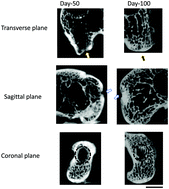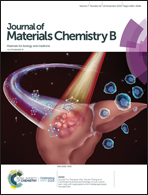Engineering a multiphasic, integrated graft with a biologically developed cartilage–bone interface for osteochondral defect repair†
Abstract
Tissue engineering is a promising approach to repair osteochondral defects, yet successful reconstruction of different layers in an integrated graft, especially the interface remains challenging. The multiphasic, functionally integrated tissue engineering graft described herein mimics the entire osteochondral tissue in terms of structure and composition at the cartilage, bone and cartilage–bone interface layer to repair osteochondral defects. In this manuscript, we report the fabrication of a multiphasic graft via bonding of a cartilaginous hydrogel and a sintered poly(lactic-co-glycolic acid) microsphere scaffold by an endogenous fibrotic cartilaginous extracellular matrix. We demonstrated that culturing chondrocytes within the alginate hydrogel conjugated to the poly(lactic-co-glycolic acid) scaffold allows for (i) gradient transition and integration from the cartilage layer to the subchondral bone layer as assessed by scanning electron microscopy, histology and biochemistry, and (ii) superior tissue repair efficacy in a rabbit knee defect model. Industrialization of the graft remains an unsolved challenge as after decellularization the tissue repair efficacy of the graft decreased. Taken together, the multiphasic osteochondral graft repaired the osteochondral defects successfully and has the potential to be applied clinically as an implant in orthopaedic surgery.



 Please wait while we load your content...
Please wait while we load your content...